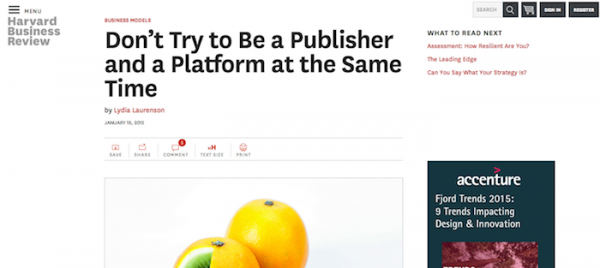
via the Harvard Business Review
An eminent industry observer on the temptations of becoming platisher
The Harvard Business Review recently published a piece on the current “platisher” trend, a term Jonathan Glick coined in 2014.
At Mequoda, we believe that term is just another fad. Multiplatform publishing, on the other hand, is our raison d’etre – we advocate strongly for originating content on your site and then distributing it across social media, while continuing to update and repurpose it across your products, fueled by participation from readers – but the HBR brings up some valid points about quality control.
In other words, there’s no need to commit to a platisher mindset as long as you’re incorporating elements of both platforms and publishers.
“Typically, publishers are considered to have editorial judgment, while platforms lack it. From this perspective, the Harvard Business Review, The Atlantic, and The New York Times are classic ‘publishers’ – they present highly curated content, and their editors invest a lot of time in its creation,” Lydia Laurenson writes. “Google, Facebook, and Twitter are classic ‘platforms’ – they distribute other peoples’ content without as much editorial oversight. But these differences are largely cultural. It’s not technologically difficult for publishers to add platform-like elements, and vice versa.
“On the other hand, the technologists looking to differentiate their platforms are drawn by the voice and influence of publishing. Plus, platform-builders can capture more value if they own content on their platform, and not just the platform itself.”
Medium, of course, comes up in this conversation, as the Ev Williams product started out as a site for commissioned long-form articles before phasing into a forum for outside contributions – earning the “platisher” moniker. Initially, as HBR points out, Medium concentrated on hiring writers and editors, while imposing access controls on potential account holders. The company raised a quarter of a billion dollars in 2014, but some conflict arose when the model shifted to a more user-based approach.
For most publishers, there’s no so such luxury. You must commit to a business plan from Day 1 – and, make no mistake, it is a business plan. In order to monetize the articles you produce, audience development is the overriding goal. You’re not curating content – you’re creating it, packaging it, repackaging it, and making sure it reaches as many people as possible, as often as possible.
This way, you’re in control, while at the same time capitalizing on the potential of platisher goals: Cranking out quality content informed by distinct user participation. It’s not about restricting access to readers, but rather giving them more options: posts, ebooks, social engagement, video, freemiums, and more. Keep it simple with old-school principles while adapting to changing technologies, and your digital efforts will be rewarded.
What do you think of the platisher phenomenon? Have you tried to merge your traditional content with user contributions? Let us know what you think, and share your strategies in the comments!
To read more about platisher perils and perks, visit the Harvard Business Review.


